Dogs that exhibit changes in energy levels and sleep patterns, gastrointestinal issues, mobility problems, gum changes, fever, itching and gnawing, and behavior changes may be sick.
Some symptoms resolve on their own in a couple of days, monitor your dog's condition for signs of acute distress such as extreme lethargy, fever, and difficulty breathing that require emergency veterinary intervention.
Give your dog all prescribed medications on time, take care of wounds and dressings, feed them vet-recommended food, and provide a comfortable space for them to rest and recover.
Dogs can't express to their owners that they are sick but they wouldn't even if they could. Wild animals are hard-wired to hide pain, injury, and illness to protect themselves from predators when they are in a weakened state. Although they have been domesticated for thousands of years, dogs still have this behavioral trait. It makes it difficult to determine if your dog is in pain, especially since canines are so loyal and loving that they have been known to jump up and greet their humans, even with fractured bones and other injuries.
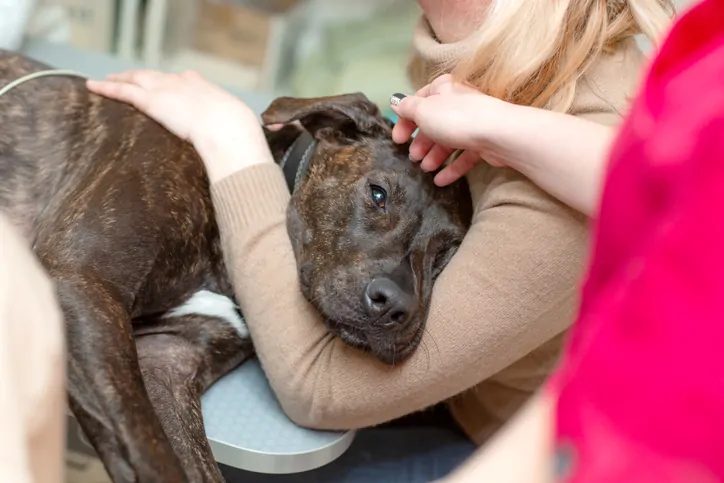
Dogs are creatures of habit that often develop observable routines which can give clues related to their well-being. Take notice of when your dog is active or at rest and be watchful for changes in those patterns. If your dog appears lethargic, it could say a viral, parasitic, or bacterial infection as well as anemia, injury, poisoning, or reaction to the medication. If your dog appears to have trouble getting a comfortable sleep, seems restless during normal sleep times, or gets up more often in the night, it could be a sign of pain and discomfort. Also, sleeping more than usual could mean your dog has a serious medical issue such as hypothyroidism, kidney disease, diabetes, arthritis, or heart issues.
One of the most obvious and disagreeable signs of sickness in your dog is the development of a gastrointestinal issue. Gastrointestinal disturbances come in a variety of forms including:
Dogs with joint issues, hip dysplasia, arthritis, fractured bone, infections, or other ailments may have trouble walking, rising, and jumping. If your dog is not taking stairs or jumping onto the bed or couch, as usual, this could be a sign that they are experiencing joint pain or have an existing injury. Dogs that show reluctance or stiffness when getting up may be exhibiting early signs of osteoarthritis. Lower activity levels and disinterest in play might also signal mobility issues.
Dog's gums are pink and moist. Pale gums can indicate anemia or shock. Shock is a serious condition caused by trauma, blood loss, heatstroke, burns, infections, allergic reactions, poisoning, and other acute conditions. When dogs are in shock, their organs don't get enough blood or oxygen which can lead to permanent organ damage or even death. Other gum changes to watch out for include:
Normal body temperature for dogs ranges from 101-102.5 degrees. Elevated temperature in dogs is related to a variety of conditions from bacterial, viral, and fungal infections to infected wounds, immune disorders, or even cancer. When taking your dog's temperature, lubricate the thermometer with something like petroleum gel or baby oil beforehand. Then, carefully place the thermometer about an inch inside your dog's anus and watch for the readings. Typically, the thermometers used for this purpose register within 60 seconds.
Itching, gnawing, and biting parts of their body are also signs that sick dogs may exhibit. These behaviors are associated with flea infestations, canine allergies, and certain infections, and are often accompanied by redness, hair loss, swelling, abnormal odor, and discharge.
Sudden behavioral changes in dogs, such as aggression, biting, or over-protectiveness of certain body parts, might also raise red flags. Aggression and biting, for instance, might be signs of canine rabies. Dogs may avoid contact or snap at you if they are in pain. If your dog starts acting, they may be sick or injured.
The best course of action for addressing canine illness or injury is dependent on the type and severity of the issue.
Many pet owners experience feelings of helplessness and anxiety when their four-legged family member becomes sick, but the truth is that no one is more capable of helping your dog feel better than you. To that end, you should always administer medication at the proper times and treat wounds and dressings by your vet's instructions to speed up your dog's recovery from illness or injury. Most importantly, show your dog a lot of affection, reassure them that you love them, and encourage them to eat vet-recommended food. Also, make sure your dog has a cozy place to rest and recover in peace. As your dog starts to get better, you can re-introduce them to their normal routines and activities with permission from your vet.
To begin raising your puppy, you should schedule their first vet visit, puppy-proof your house, feed them high-quality food, train and socialize your puppy, and spay or neuter after they mature.
Your puppy will be examined, vaccinated, and tested for worms. Your vet will also instruct you in the care requirements for your puppy based upon their breed and condition.
Once your pup is 8 weeks old, you can begin teaching simple commands in 5-10 minute training sessions that include lots of positive reinforcement.
Puppies. They're so cute that simply saying "puppies" is enough to make most dog lovers smile. And they're irresistible. The instant you pick up a puppy, you feel compelled to take it home. Next thing you know, there's a barking, shedding, chewing bundle of fluff roaming all over your place. Whatever strange powers puppies may have over us, the enchantment begins to fade after you get them home, and the reality of raising a puppy sinks in.
You don't have to fall out of love with your puppy when the spell breaks, but, if you have the right tricks up your sleeve. Here, we will reveal some puppy-raising tips that work like magic.
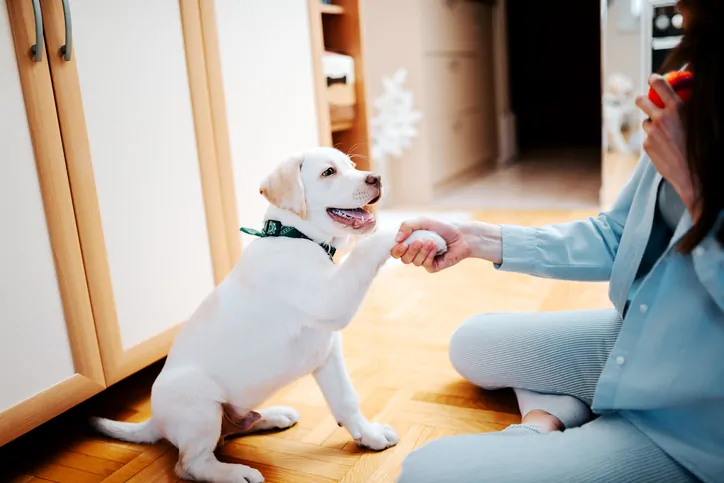
The last thing you need is for your puppy to get sick soon after you bring them home. Puppies have underdeveloped immune systems and are vulnerable to illness and injury. While puppies are nursing, they receive protection from germs through antibodies in their mother's milk. Around six weeks of age, those antibodies start to wear off, and your puppy will need to be vaccinated to remain protected.
Additionally, puppies adopted from a shelter may be exposed to other dogs that carry viruses which could prove fatal to puppies. At your puppy's first veterinarian visit, ideally between 6 and 8 weeks old, they will be vaccinated against viruses that are common in shelters including:
In addition to vaccinations, your puppy's first vet visit will include a thorough examination. Your vet may also take a stool sample to check for intestinal parasites. At the first veterinary visit, you will receive information about your pup's breed-specific care requirements including exercise needs, dental care, reproductive health, nutrition, and vaccination schedule.
Your puppy will need to return to the veterinarian a few weeks later for additional vaccines that protect against the following:
Veterinarians can start heartworm prevention at eight weeks of age. Heartworm prevention is only effective on late-stage larvae so, most heart wormers must be given monthly. If you miss a dose or are more than two weeks late, your pup will need a blood test to check for adult heartworms. Heartworm disease can cause damage to your puppy's heart and lungs months before it can be detected by a blood test, causing long-lasting, life-altering effects. Most heartworm prevention also protects against intestinal worms, and some may even include flea prevention.
A puppy-proofed home may sound like a fairy story but it can be achieved with some strategic adjustments around the house. Start with setting your home up for puppy potty training. If you are crate training your pup, ready it before you bring them home with comfy blankets and a treat or toy to tempt them in. Introduce your pup to its crate by leaving the door open for them to explore on their own. Make sure your pup has room in its crate to stand up, lie down, and turn around. Other ways to puppy-proof your home include:
The best way to keep your puppy out of mischief is to make sure they are getting plenty of exercise and stimulation. If your pup is running around the house like a wild animal, it's a good time to take 10-15 minutes to play catch, go for a walk, or romp around in the yard with your furball.
At four to six weeks old, introduce your puppy to solid food by combining kibble with a milk replacer to make a gruel. This reduces gastrointestinal discomfort and helps them adjust to solid food. By eight weeks old your puppy should be ready for dry food.
The best puppy foods feature ingredients that are healthy sources of protein, calcium, and calories. Ensure your puppies dog food has GRAIN – this is vital for a healthy heart. Try to stay away from items that include high quantities of corn or meat by-products; meat should always be the first ingredient. Three to four feedings each day are best for puppies. Smaller meals digest more and balance puppy energy levels.
You should transition your puppy to adult food as they approach maturity because puppy food is particularly high in calories and nutritional supplements. Extended use of puppy food may cause obesity and orthopedic issues.
The most beneficial training you can give your puppy is socialization. A puppy must be socialized to enjoy interactions and feel at ease with other animals, people, locations, and activities.
Socializing should start when a puppy is between 3 and 14 weeks old. Begin socializing your puppy by encouraging friends and family to hold and pet your puppy. Once your pup is 16 weeks old and fully vaccinated, visiting the dog park can help them learn to get along with their peers. Taking your puppy to the groomers early and often will teach them to tolerate being handled.
You can start teaching your puppy simple commands such as come, sit, down, and stay at around 8 weeks of age in training sessions that last no longer than 5 to 10 minutes and always end on a positive note.
Spaying or neutering your pooch reduces the number of stray dogs that end up being euthanized. Small breed dogs are mature enough to spay or neuter at around 6 months of age, while larger breeds may not be mature enough until 16 to 18 months old. Nevertheless, scheduling your pup's spay or neuter as soon as they are mature enough makes the surgery easier for your veterinarian and helps your puppy recover faster.
Ticks spread a host of serious, incurable diseases to cats, dogs, and people. Therefore, tick control and prevention are as important to your family's health as it is to your pet's. Here we will look at why tick control is important for your cat, your dog, and your family as well as some ways you can prevent these pests from causing you and your pet serious, irreparable harm.
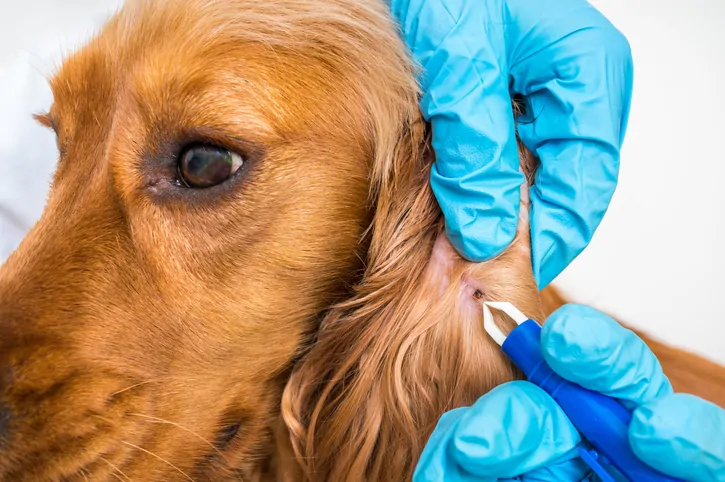
Ticks are a parasitic form of arachnid, like spiders, scorpions, and mites, that feed on both human and animal blood. They rely on their hosts to bring them onto your land or around your house because they can't fly or jump to go around. Ticks are frequently carried by wild animals when they occur in your area. Deer, horses, rats, and other types of wild animals can all serve as tick hosts. Cats and dogs typically act as carrier hosts for parasites once they are on your property, which allows the parasites to enter your home.
Ticks exist in a variety of temperature zones and are found all across the country. However, they seem to prefer the damp, shady woodlands of the Northeastern US the most. A US News report found that Pennslyvania had the highest incidence of tick-borne illness in the United States, followed by many of its east coast neighbors. Minnesota and Wisconsin in the northern Midwest also made the list.
Ticks transfer disease-causing viruses, bacteria, and microscopic parasites to pets and humans through their saliva which enters their host's bloodstream when the tick bites. The most common diseases spread by ticks include:
Many tick-borne diseases have common symptoms that can include body aches, joint pain, headache, fever, rash, fatigue, stiff neck, swollen lymph nodes, and facial paralysis.
Ticks are relatively easy to locate once they've settled in for a bite because, if unbothered, they will feed in the same spot for anywhere from 3 to 10 days. Ticks typically seek out the warm, moist cracks or crevices of their host for comfort and less chance of detection. So if you're checking your dog or cat for ticks make sure to look deep within your pet's coat, inside and around their ears, around their neck, and between their legs and toes.
To get rid of ticks on your pet and prevent them from getting new ones, most pet owners one or more of the following:
Some medications used to treat ticks in dogs are harmful to cats so make sure you purchase tick treatments that are formulated specifically for your pet. Tick control medications are often found in combination with flea control and prevention medications so be sure to check the label to see if the product you choose protects your pet from more than one kind of pest. To identify the best tick prevention for your cat or dog, consult your veterinarian.
The most obvious signs of digestive issues in dogs are vomiting, diarrhea, bloating, and loss of appetite.
Digestive issues in dogs may be caused by many things including foreign objects, food intolerance, inflammatory conditions, parasites and cancer.
To diagnose your dog's digestive issues, your vet will get a thorough history, perform a detailed examination, and order some laboratory, imaging, or exploratory tests.
Treatment for digestive issues in dogs targets the underlying issues in combination with supportive care.
Digestive issues are the most common reasons dogs end up at the vet's office. Digestive issues in dogs vary in severity, frequency, and cause.
Your dog must have a healthy digestive system to use food nutrients to create new tissue, repair existing tissues, and produce energy. It's critical to detect the symptoms of GI issues and speak with your veterinarian because they can cause dehydration, acid-base and electrolyte imbalances, and malnutrition.
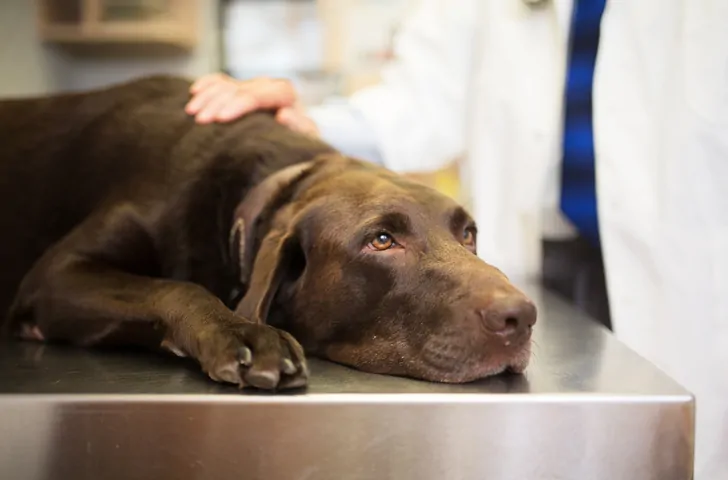
Gastrointestinal (GI) disorders and diseases that affect a dog's stomach and intestines cause pain and other issues for your beloved pet. A digestive disorder is any condition that affects how food is absorbed, digested, or moves through the digestive tract. The most common signs of digestive issues in dogs are:
Digestive issues can cause a lot of pain that your dog can't express. If your dog has a hard time getting comfortable, is sitting in a tensed or hunched posture, or bows frequently with paws and chest on the floor and hindquarters raised in the air, they may be experiencing digestive issues.
Take your dog to the vet if your dog's digestive issues last longer than 48-72 hours. Emergency vet care may be required if your pet's condition deteriorates rapidly as can happen with serious digestive illness. Blood in your dog's vomit or diarrhea, lethargy, fever, obvious signs of pain, and bloating or distention of your dog's belly are signs that indicate your dog needs urgent care.
There are literally hundreds of potential causes for digestive issues in dogs. Digestive issues can present suddenly or develop gradually. Some of the most common causes of digestive issues in dogs include:
Your veterinarian will thoroughly investigate the cause of your dog's digestive issues. This includes asking questions about anything your dog may have been exposed to and requesting a detailed description of their symptoms to get an accurate history of your dog's digestive issues.
Your vet will also perform a physical examination that entails palpating the belly for indications of anomalies, as well as assessing your dog's temperature, pulse, heart rate, lungs, level of hydration, gland/lymph node activity, and other things. This helps to plan which diagnostic tests to use and provides important information about the health of a dog.
Laboratory testing reveals information about what is happening inside your dog's body. Based on the information you provide for your dog's health history and the observations of your vet during the physical exam, your vet may order diagnostic procedures such as:
Except in urgent care cases, your vet will likely order the most basic tests first and only move towards more invasive testing procedures if your dog is not responding well to initial treatment.
Treatment for digestive issues in dogs targets the underlying issues involved. A dog with intestinal parasites, for instance, would be treated with a dewormer, whereas a dog with an obstruction would need surgery. To put it another way, the type of treatment depends on what's causing the intestinal issue.
Supportive care is required as well. Anything that is done to reduce symptoms and complications, such as dehydration from vomiting, while making your dog feel more comfortable is considered supportive care. Supportive care treatments include medications for nausea, gas, and diarrhea as well as probiotics, plain foods, and fluid therapy.
If your pup is otherwise healthy and is keeping food and water down but has started showing mild signs of digestive distress, it is usually fine to observe them for a couple of days and try a few simple home remedies including:
This method is not safe for puppies, older dogs, and small breeds because they cannot tolerate calorie restriction.
Most serious conditions that cause digestive issues in dogs can not be prevented. However, the most common causes of GI distress in dogs can be prevented by following these tips:
Dogs experience digestive problems, and most will experience at least a few episodes of an upset stomach during the course of their lifetime. You can keep your furry friend as healthy as possible by taking precautions and getting your dog to a veterinarian right away if they aren't feeling well.
Stinky breath in dogs may be caused by periodontal disease that can result in tooth loss, abscesses, and systemic infections.
Yes. Neglecting your dog's dental care may cause serious health issues that can take years off their life.
Proper dental care for dogs includes regular examinations and frequent at-home dental hygiene, as well as dental cleanings by your vet as needed.
Brushing your dog's teeth with a vet-approved toothpaste at least two or three times a week is the best way to care for your dog's teeth at home.
If your dog resists brushing, you can give them treats, chews, and food additives that help scrape tarter off their teeth as they chew and promote healthy bacteria.
Canine dental disease caused by poor dental hygiene is a common problem faced by the majority of dog owners. Most dogs begin to exhibit symptoms of canine periodontal disease by the age of three. Dog guardians ignore their pet's foul breath because they believe that it's natural for it to be stinky. But, bad breath in dogs is usually the earliest warning sign of periodontal disease. Untreated dental disease can result in tooth loss, excruciating abscesses, and systemic infections that affect every part of your dog's body. Periodontal disease also increases the risk of canine heart disease and can cause permanent jaw damage.
Periodontal disease in dogs is irreversible and can take up to two years off your dog's life. However, there are things that you can do to prevent periodontal disease or even help slow disease progression when combined with veterinary treatment.
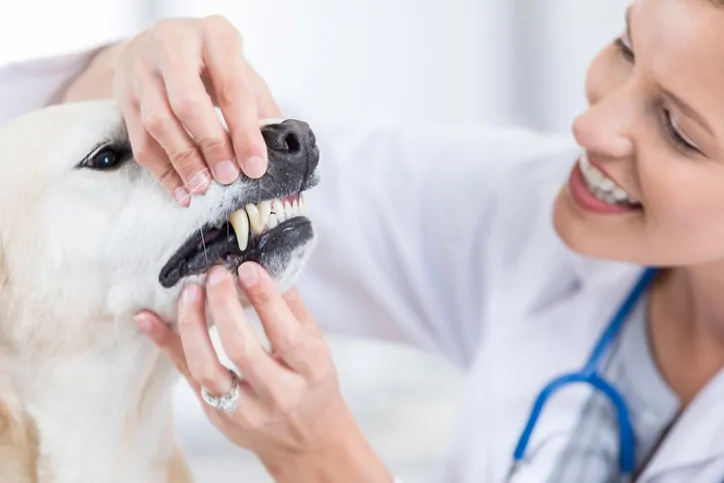
Brushing your dog's teeth is a great way to stop plaque from accumulating and prevent periodontal disease. Although it's best to brush frequently, you don't have to clean your dog's teeth every day. Your dog may resist having their teeth brushed at first, but, with patience and consistency, they can be trained to accept the process without much fuss.
Using toothpaste flavored to appeal to a dog's taste receptors can help make them more cooperative, and is necessary because human toothpaste has ingredients that are toxic to pets. The three most preferred tastes of doggy toothpaste are chicken, beef, and peanut butter. Be cautious of your pet's food sensitivities when choosing their toothpaste flavor.
Taking care of your dog's teeth is like taking care of your own. Moisten the toothbrush, dab some toothpaste on it, and then brush your dog's teeth. Don't worry if your dog will not allow you to brush the inside of their teeth, and you don't have to rinse the toothpaste from their mouth when you're done brushing. You can use a standard human toothbrush on large dogs but it is advisable to use a fingertip brush or a baby toothbrush when brushing little pets.
Do not attempt to brush your dog's teeth if you are worried that they may bite you. Try some of the following alternatives instead.
Fluoride is toxic to pets. Only use toothpaste made for animals. Ask your veterinarian for toothpaste.
A great method to enhance your dog's oral health is by giving him dental treats. Dog dental treats are designed to eliminate plaque buildup and include chemicals that help your dog's breath and mouth stay fresh and clean. You can find dental treats in a range of colors, textures, and flavors that your dog is sure to appreciate.
There are countless varieties of dog chews, and all contain teeth-cleaning qualities. The act of chewing in itself is good for your dog's oral health. The chewing removes plaque from your dog's teeth, and a lot of natural meat-based chews also contain enzymes that support dental health. Many durable rubber or nylon dog chew toys are also effective if you're searching for something with no calories.
Give your pet chews and raw hides formulated by veterinary dentists and under supervision.
A few dog food manufacturers produce prescription dental food, which has been clinically proven to help minimize dental disease for dogs that don't like brushing or are especially vulnerable to periodontal disease. As your dog chews, the kibble cleans the surface of their teeth, preventing the formation of tartar. Ingredients in the kibble also aid in eradicating bacteria that cause plaque and tartar to form. You may need to talk to your vet about these dental diet formulas for your dog because they often require a prescription from a vet.
Flavored dental powders can also help you protect your dog's dental health with probiotics that promote healthy bacteria and kill the bacteria that cause plaque. As a result, these powders help your dog's breath smell better and keep plaque and tartar from forming on their teeth. You can apply the powder to your dog's food as instructed by the product's instructions.
There are a variety of water additives that all function quite similarly. These oral medications have no flavor and can be added to your pooch's water bowl as directed by the instructions on the bottle. You should add a specific quantity of the water addition to your dog's water bowl each day in accordance with the instructions on the bottle. The remedy eliminates plaque-forming bacteria in your dog's mouth while also helping to freshen their breath.
The best way to safeguard your dog's oral health is to have regular dental examinations performed by your pup's veterinarian. Veterinarians have dentistry training that allows them to recognize dental health issues that may go unnoticed by even the most devoted dog owner. Your vet will recommend a dental cleaning when your dog's mouth shows signs of too much tartar build-up or emerging gingivitis. To effectively remove all the tartar from your dog's teeth and under their gum line, a veterinarian will need to put your dog under general anesthesia. Most dogs need a dental cleaning every two or three years, even if they have regular dental hygiene at home.
Diarrhea in dogs can be caused by anything, including eating garbage, food intolerance, parasites and stress along with certain viruses and bacteria.
The course of treatment is determined by the cause of your dog's diarrhea but may consist of an anti-diarrheal agent, fasting, bland food, and probiotics.
Follow all veterinarian instructions, especially pertaining to the proper diet. At-home treatments include fasting, boiled chicken with white rice (bland diet), bone broth, probiotics, and fiber supplements.
Dealing with diarrhea in dogs is not only a nasty business but it's also a common problem most pet caregivers face. Diarrhea varies in severity, duration, and frequency from breed to breed. While canine diarrhea isn't always preventable, there are ways to decrease the incidence of this unpleasant condition in your furry friend. .
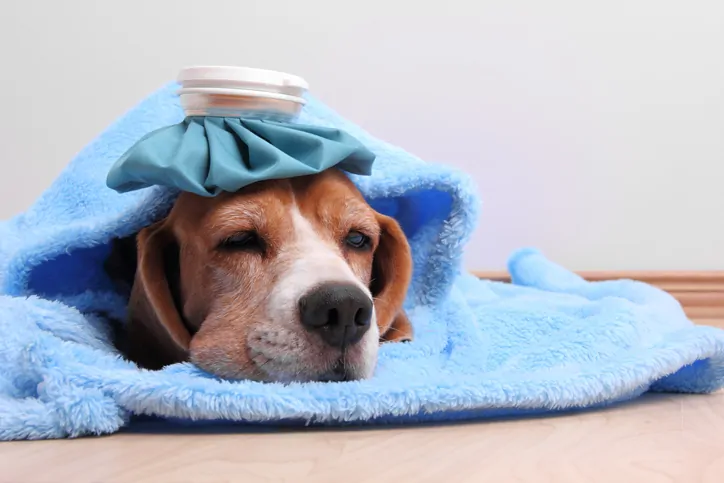
Diarrhea is characterized by the faster transit of feces through the intestines combined with a reduction in the absorption of water, minerals, and electrolytes. When diarrhea is a dog's primary symptom of illness, it may be caused by a very straightforward issue, such as an intestinal infection brought on by bacteria, coccidia, or intestinal worms such as hookworms, roundworms, or whipworms.
A change in diet or dietary misconduct (eating trash or other irritating foods) is a frequent cause of acute diarrhea in dogs. Acute diarrhea can also be brought on by stress, particularly after traveling, boarding, or experiencing other environmental changes. Other causes of diarrhea in dogs include:
When your dog has diarrhea, most of the water they drink is passed through the body instead of absorbed by the intestines. This causes gradual dehydration that can cause electrolyte imbalances and put a strain on the kidneys resulting in organ failure. Seek veterinary care if your pet exhibits the following symptoms:
If diarrhea doesn't resolve within 48 to 72 hours, you should seek veterinary care for your pup.
When you take your dog to the veterinary hospital, the first thing your vet may want to do is diagnose the cause of their diarrhea symptoms. Your vet will test your pup's stool for intestinal parasites, Giardia, and certain kinds of bacteria. Blood might be taken to catch signs of metabolic disease, protein loss, anemia, inflammation, and other conditions. Other tests including CPL tests, radiographs, and ultrasound may be necessary.
Your dog's diarrhea treatment plan is dependent on the results of their tests. Parasites can be treated with dewormer. Bacteria populations may be managed with probiotics. Anti-diarrheal agents and food restrictions may be prescribed to reset your dog's gut. If your dog does not respond to initial treatment within 48 to 72 hours then more tests and new treatments may be needed.
Canine diarrhea resolves on its own in a day or two. In most circumstances, there is no cause for concern because many dogs with diarrhea act and feel fine. A short fast (12 to 24 hours) followed by a bland diet is all that is needed to stop diarrhea in dogs, but, young puppies should not fast. Some home-care remedies for doggy diarrhea are:
Once you find a recovery diet that agrees with your dog, you can increase their portions over the course of a few days. Dogs with uncomplicated diarrhea usually make a full recovery, but those with chronic diarrhea may need long-term medication or nutritional therapy to keep their diarrhea issues under control.
Cats become infected with roundworms by ingesting worm eggs or nursing from infected mothers.
Roundworms are nematodes that occur as parasites within other animals and live primarily in their intestines.
Roundworm infection primarily causes digestive issues such as vomiting, diarrhea, and bloating, but can also cause anemia, weight loss, coughing, stunted growth, and vision loss.
Roundworms in cats are diagnosed through a stool examination, a fecal flotation test, or a protein antigen test.
Your vet will administer anthelmintic medication to your cat which kills parasites. Additional medication may be sent home or administered by your veterinarian at your cat's next checkup.
Staying on monthly, year-round prevention –routinely deworms them monthly as well as protects them from heartworm disease and fleas. Strict hygiene, rodent control, and periodic de-worming are a few ways you can prevent roundworms in cats.
The most common parasite that infects your cat is the roundworm. Roundworm infection occurs when cats ingest infected eggs or nurse from infected mothers. Also known as ascarids, roundworms use up the nutrients from your cat's food as it travels through their intestine, causing weakness. Roundworm infection in cats puts the whole family at risk as it can be spread to humans if they have an open wound when they pet an infected cat, clean litter boxes, or are otherwise exposed.

Roundworms are long, bilaterally-symmetrical nematodes that are tapered at both ends. Nematodes live in a variety of habitats, including soil, freshwater, marine, and deep water-filled crevices in the Earth's crust as well as in vinegar and beer malts. Nematodes, such as roundworms, exist as parasites in plants and animals. The roundworms found in cats average about 3 to 5 inches in length and are called Toxocara cati. Although Toxocara cati can spread to humans, the parasite does not mature to adulthood within a human host.
Roundworms pose a higher threat to kittens than they do to healthy adult cats. Regardless of age, cats with small worm populations may show no symptoms. While adult roundworms live in the intestines, roundworm larvae can travel throughout the lungs, liver, and other organs. These worms can cause damage to your cat's organ tissue, nerves, and even eyes. Other symptoms of roundworm infection include:
Significant numbers of worms moving into your cat's lungs may cause frothy nasal discharge, pneumonia, fluid in the lungs, breathing problems, and even death. Kittens suffer more severe complications from roundworm infestations that can include:
You may discover adult roundworms in your cat's poop or vomit. Adult roundworms have a white or light brown hue, and can be several inches long.
To diagnosis your cat, a veterinarian can perform a fecal flotation test. The test is performed by mixing a small amount of your cat's stool with a liquid solution which causes roundworm eggs to float to the top. Any eggs that are found may be examined under a microscope on a transparent slide.
False negatives are common because some cats are infected with immature roundworms that haven't reproduced yet. On occasion, adult worms are found in a cat's stool, which helps with diagnosis. Your vet could also use a test that detects a particular roundworm protein antigen in cat feces. Best practices dictate that your cat or kitten should receive roundworm treatment even if they test negative.
The good news is that roundworms are comparatively easy to treat in cats. Roundworms are treated with a de-worming medication, or anthelmintics, which kill parasites by causing paralysis or inhibiting the ability of young worms to mature into adults. Anthelmintic drugs that are effective for roundworm infections in cats include:
Over-the-counter dewormers are not recommended as a roundworm treatment for cats because roundworms have a complex life cycle. To be sure all adult roundworms and larvae are eliminated, your cat should be treated by your veterinarian. More roundworm treatments may be sent home or administered at your cat's next check-up.
If the right roundworm medication is administered promptly, the prognosis for roundworm infection is good. However, extremely diseased kittens sometimes pass away.
Roundworms can enter your cat's body in a variety of ways, therefore it's important to keep your cat's living space sanitized, and if at all possible, keep your cat inside to prevent them from consuming wild animals that might be roundworm carriers. Some other measures that prevent roundworm contamination are:
Strict hygiene can help prevent the spread of roundworms to humans. Symptoms of roundworm infection in humans include cough, fever, restlessness, stomach pain, vomiting, and wheezing. Adult roundworms may be present in human stool. Roundworms are treated in humans with a medicine that kills roundworms in around3 days.
Trauma-related corneal damage is the most common eye condition in dogs, followed by dry eye disease and conjunctivitis (pink eye).
Symptoms of common dog eye conditions include red or pink eyes, cloudy eyes, discharge, squinting, swelling, itchiness, and pain or distress.
Trauma is the most common cause of dog eye conditions, often in combination with a secondary infection.
Treatment for common eye conditions in dogs ranges from medicated eye drops and oral medications to surgical interventions.
Preventing eye conditions in your dog consists of avoiding situations where your dog's eyes may be injured along with maintaining regular wellness visits to detect any eye changes early.
Common dog eye conditions can range from little irritants, like allergies and minor scratches, to more severe conditions, like glaucoma and significant wounds. Whatever the underlying reason for your dog's eye condition, the most important thing is to act and seek veterinarian care as soon as possible because even minor eye issues can get worse.
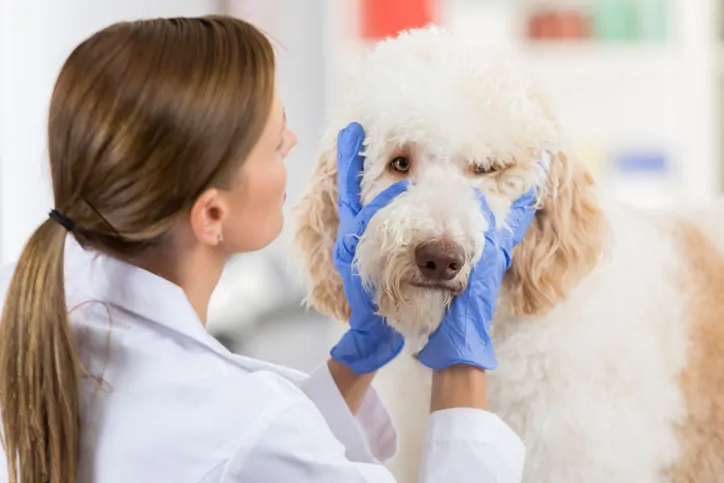
The most common dog eye conditions are corneal damage, caused by trauma, followed by dry eye and pink eye. Other common eye issues in dogs include eyelid masses, cataracts, glaucoma, and cherry eye. Here are some of the symptoms your dog may have if they are suffering from one of these conditions:
Symptoms of common eye conditions in dogs may appear in one or both eyes. If you notice tearing, tear-stained fur, discharge, closed or squinted eyes, a visible third eyelid, or pupils of unequal size, your dog may be experiencing a serious eye condition and you should call your vet immediately to schedule a consultation.
There are several causes of eye conditions in dogs. The most prevalent dog eye issues are associated with trauma and certain eye conditions occur more in some breeds than others. Here are several eye conditions that commonly affect dogs:
Eye conditions in dogs need a proper diagnosis for effective treatment. Once your dog exhibits symptoms, take them to the vet because symptoms can escalate in a short period of time. Your vet can perform a series of tests to identify the issue and establish a treatment plan.
One of the first tests your vet may perform is the Schirmer tear test. This examination gauges your dog's ability to produce tears by placing small paper strips are placed beneath your dog's eyelids for one minute.
Your vet may also order a fluorescein stain which checks the surface of your dog's eye for blemishes, ulcers, and other abnormalities. It can also be used to assess the drainage and quality of tears. This test consists of the application of a green stain to each eye, followed by an examination of the eyes under a special blue light.
The most important test is the measurement of eye pressure. Certain eye conditions can induce changes in ocular pressure that can be painful and cause serious complications. A sensitive pressure-measuring instrument is used to tap the eye's surface throughout the procedure. Don't worry, numbing eye drops will be applied, so your dog will be comfortable during this process.
Blood tests and cultures may also be ordered to check for bacterial growth or other underlying conditions, depending on your dog's symptoms.
Your dog's physical examination and diagnostic test results will be used to guide the course of treatment. Here are a few typical remedies:
It's also good to know that many of the drugs offered as doggie eye "drops" are available as ointments. Your veterinarian can advise you on which option is best for your pup.
Unfortunately, not all eye issues can be avoided. However, there are certain things you can do to reduce the risk for your dog:
Avoid situations that could cause eye injuries, such as letting your dog run through bushes with pointed branches.
Have eye conditions treated by your dog's vet as soon as possible. If left untreated, eye issues can quickly worsen. Early intervention may prevent complications and keep your dog more comfortable.
Attend routine checkups as advised. Wellness checkups assist in spotting early warning signs of eye conditions in your dog and allow for quicker treatment and better outcomes.
While disorders such as glaucoma or deep ulcers may call for more intensive care, the majority of eye issues are easy to manage and have fast recovery times. So, it is likely that your dog will return to normal if you seek veterinary care for your furry family member as soon as their eye condition becomes noticeable.
For many pet guardians, their four-legged companions are their most loyal and loving friends. It's a bittersweet connection, knowing that, chances are, you will outlive your beloved pet, and be faced with that grief. Consequently, many animal lovers observe the signs of aging in their pets with trepidation. However, pets age in stages, and, like with the aging humans in our lives, their golden years are an opportunity for us to treasure our time with them and show our gratitude for the love and laughter they bring to our lives.
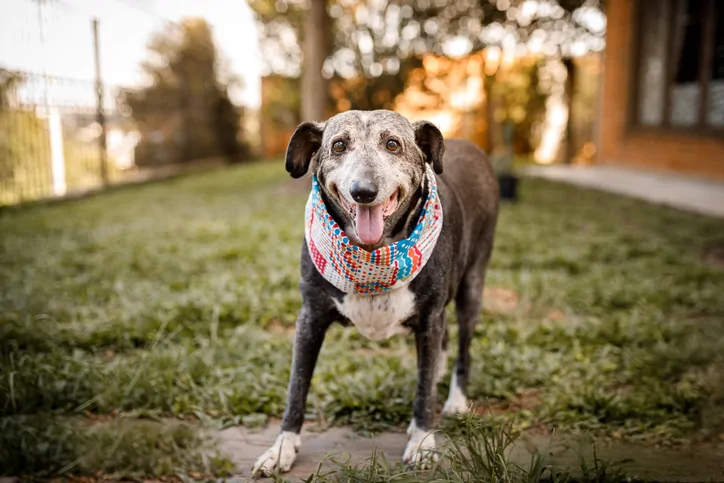
Small dogs and cats are typically categorized as "seniors" at seven years old. In comparison to smaller breeds, larger breed dogs tend to live shorter lives and are frequently regarded as “seniors” around the age of 5 to 6 years old. Pets are surviving longer than ever thanks to advances in veterinarian treatment and dietary practices but may still experience age-related issues. Nevertheless, with the right care, your furry family member can age happily, healthily, and actively.
Dogs and cats experience many of the same age-related health issues but the signs of illness can manifest in different ways. Signs of aging in dogs include:
Cats show more subtle signs of aging than dogs, so you may have to be especially observant with your elderly cat. The signs of aging in cats include:
Noticing signs of aging in your pet does not mean it's time to panic, it simply means your pet may need extra care and attention going forward. Subtle changes to your pet's routine, vet care, and changes to their environment can help them stay healthy longer.
No matter what species your pet may be, all elderly pets benefit from semi-annual veterinary visits, geriatric diets, low-impact exercise, and changes to their environments. Semi-annual veterinary visits make it possible for vets to detect signs of illness quickly for more effective treatment and better outcomes. Doing senior blood work every 6 months to a year for early detection is key.
Parasite control and dental care are also vital to the health of older pets. Your vet will perform more in-depth examinations as your pet ages and may do periodic lab work to check your pet's liver and kidney function.
Geriatric pet diets consist of easily digestible ingredients with calorie levels that are more appropriate for aging pets and include anti-aging nutrients. Your vet can recommend the best formula of high-quality pet food for your pet's specific needs.
Low-impact exercise helps keep aging pets active, eases joint pain, and improves mobility. For pets who suffer from arthritis, specialized diets, joint supplements, and anti-inflammatory medicines formulated for pets may ease your pet's symptoms and help them feel like being more active. Alternative therapies for pet arthritis include acupuncture, electron conversion therapy, chiropractic care, and stem cell therapy. In extreme cases, your vet may use a surgical approach by removing damaged tissue or replacing worn joints.
Assistive changes to your pet's environment can help them maintain their daily routines. Providing soft, non-slip surfaces for pets to walk on and ramps for climbing into cars or onto couches help many pets with mobility issues. Keeping your pet warm and supplying them with comfortable bedding soothes joint pain.
Some of your pet's care needs may be species-specific. For instance, dogs need more exercise and activity to stay mobile than cats do. Elderly cats who aren't feeding well benefit from having water and food bowls in several places around the house so they don't have to go far to feed, whereas, dogs are better served by providing elevated food bowls. Dogs benefit from the use of support slings for assistance with walking and climbing into the car but such devices are of little use to cats.
If your pet has a serious condition and there is no hope of recovery, pet hospice care, referred to as palliative care, is an option. The idea is to utilize the right combination of painkillers, nutritional modifications, and human interaction to make your pet's final days or weeks more bearable. Pet hospice is not a physical location, but rather a philosophical and personal decision based on the idea that dying with dignity is both possible and a natural part of life. Pet owners should be cautious not to prolong the suffering of animals who are in pain or have a poor quality of life when considering hospice care.
If your pet is suffering, the most compassionate option may be euthanasia. Euthanasia can end your beloved pet's suffering without pain. Veterinarians receive specialized training to provide your pet with a dignified and humane end. The process involves an injection of a sedative, followed by an injection of a specific drug. The treatment, which lasts between 10 and 20 seconds, is comparable to receiving general anesthesia during surgery and causes the animal to have no awareness of what is happening.
Following the loss of a cherished pet, it's common to experience a range of difficult emotions. No matter what you are feeling, remember that there is no right way to mourn. Try to remember the good times and build a support system that includes people who loved your pet as much as you. if the intensity and duration of your grief become overwhelming, it is best to talk to your doctor or a mental health professional to develop a treatment plan that can help you feel better moving forward.
If your pet's wound is deep, includes bite marks, has a deep puncture hole, has become infected, or your pet show signs of pain, then your pet needs veterinary attention.
Depending on the type of wound, your pet may need antibiotics, stitches, surgical debridement, or a Penrose drain.
Apply pressure to stop bleeding from your pet's wound, then clean it with antibacterial soap and rinse well. Light ointment and bandaging may be needed as well as an e-collar to prevent your pet from licking the wound.
Pets often suffer from cuts and scrapes and minor injuries that can usually be treated at home. However, because most pets are covered with thick fur coats, it can be difficult to see if the injury is serious.
When inspecting a wound on your pet, exercise caution. When in pain, any pet may bite, even if they are usually very docile. Wrap your pet in a towel or a muzzle to be safe.
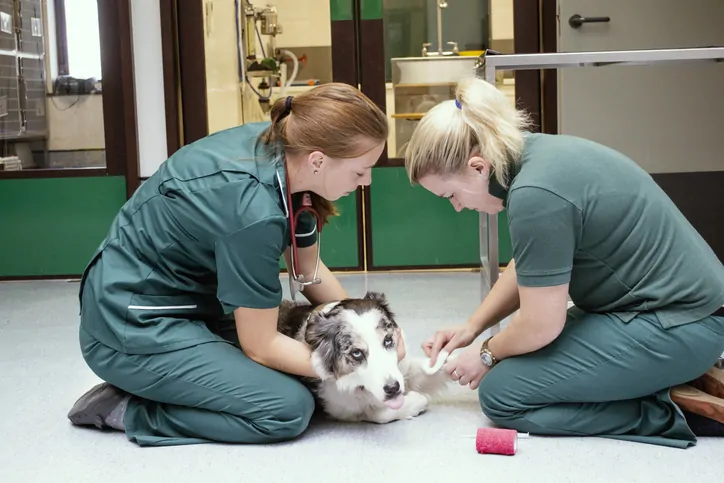
Sometimes when your pet is wounded, it's obvious that they need veterinary attention right away. However, cats and dogs are notoriously stoic, so it's possible for their injuries to seem minor when they are actually quite serious. Some things to look for when assessing your pet's condition are:
Your vet will carefully examine your pet, assess their wounds, and look for any other injuries. For examination purposes, your pet's hair may be removed. X-rays could also be required for some wounds. Some sedation may be necessary to keep your pet calm during the examination.
The goal of wound care is to prevent infection from taking hold and spreading while permitting the wound to heal. Different approaches are needed to achieve these objectives for various types of wounds. To treat the wounds properly and without exacerbating your pet's agony, sedation or anesthesia is typically required. Various wounds and their treatments include:
When your pet is ready to go home, your vet will provide instructions about how to clean and change your pet's bandages as well as any antibiotics or pain medications your pet may need.
If there's a drain in place, let the fluid drain from the wound before using a warm, moist towel to gently clean up the debris and avoid clogging the drain. To prevent your pet from licking the wound and making it worse or from removing sutures or drains, use an Elizabethan collar.
If your veterinarian has to remove a drain or stitch or do a recheck examination, do so promptly. Even brief delays might harm your pet and lengthen the recovery process.
Minor wounds such as small cuts and scrapes may be treated at home and observed for signs of infection. The following steps can prevent infection in your pet's wound:
If the wound develops signs of infection such as redness, swelling, odor, discharge, or heat at the wound site, take your pet to their veterinarian's office as soon as possible.
Phone: (855) 461-8259
Email: [email protected]